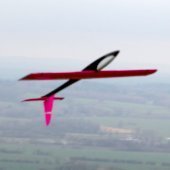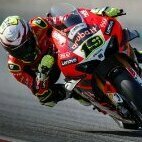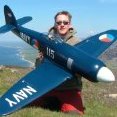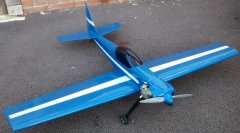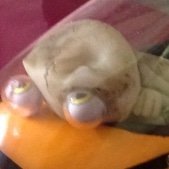Leaderboard
Popular Content
Showing content with the highest reputation on 21/12/21 in all areas
-
So, I've added some basic insignia. I hand made these using white Oratex and black vinyl tape. I dulled down the tape by sanding lightly and covering with matt water based clear. More flying after Christmas eh! Hope you all enjoy the festive season.. Cheers from Sunny Australia3 points
-
This looks much nicer - and no more wobble! The OS one (with correct OS washer) from Just Engines:2 points
-
Not sunny, but 2 mph gusting 4 mph was just too much of an opportunity not to be missed this lunchtime. Even managed to land it on the third attempt by trimming the tick over to super slow, that Laser 150 still shifts some air even at that RPM! Still surprised that the rudder is so ineffective on the ground and lively in the air ?2 points
-
The end of Solarfilm is a sad story for a once very successful business that was in its time a world leader. However, along with so many other British manufacturing companies in various sectors and of all sizes, they took their eye off the ball, didn't modernise production (look at the article that appeared in RCM&E just before they threw in the towel) and didn't diversify outside of what was a clearly shrinking (no pun intended) market. I am surprised that some way to continue the manufacture of Solartex wasn't found, given its global following and popularity. Oracover still continue to trade after over forty years of business https://www.oracover.de/about-us.html so clearly they're doing something right and are able to fend off cheaper opposition.2 points
-
Jonathan Nigel R has made the point I forgot to make. You must use a rate for aerobatics and one for spinning. I hear that people don't like using switches in flight. Well, that would cut out use of retracts and flaps then. Sorry, flying proper aerobatics requires you should make use of rates and expo to give you the right movement for the phase of flight you are in. As you have already found, optimising elevator movement for aerobatics doesn't cut the mustard when it comes to spinning. If you use one elevator rate that enables the aircraft to spin it will work against prrecision in all other aerobatic manoeuvres. I use 3 rates: aero; land; spin. Actually, I can and do use 2 other rates, if needed, for slow and very slow rolls. Bite the bullet and you will find that you can have the best of both worlds?2 points
-
i think this myth about high nitro fuel being better (especially for 4 strokes) comes from the fact that many people never touch their slow run needles. I have gone over this before, but manufacturers like os and saito ship their engines with slow run needles set quite rich. Why? because they do not test run them a rich slow run almost guarantees the engine will at least start. If the engine is set 'correctly' without running the engine there is a chance it will be a shade lean for that specific engine and the engine will not start. This causes problems as many people really struggle with diagnosis of an engine that will not fire up at all. So you fire up your new beast on 5% fuel and it idles badly, shakes about, stops etc. This happens until the club expert tells you to use 10% nitro and hey presto! much better. So you conclude that high nitro is better and the myth continues. The reality is that high nitro fuel needs a richer mix than lower nitro and the change to 10% fuel often brings the engine into tune with the formerly rich slow run tuning it shipped with. For the sake of maybe 2 minutes with a small screw driver the slow run needle could be adjusted to suit the 5% fuel you started with and the engine would perform just fine. The other one is my personal crusade, tank placement. High nitro fuel will to some degree allow a little more tolerance if the tank placement is poor. So for the small amount of effort needed to get the tank placement right and tune up your slow run needle you can ditch the expensive and thirsty 10+% fuel and drop to 5. It will save you money, make the model cleaner, give longer flight times, and you can be all smug when your engine just keeps going and going ?2 points
-
Merry Christmas to all of our PSSA members in the UK and around the world - many thanks to everyone whos helped make 2021 a successful and memorable flying season!2 points
-
Not sure I agree with Shaun, I thought that if you increased the wing loading it would have the same effect irrespective of altitude ? or is the 150 ft needed to get it to pull out of a dive with all the extra weight of additional covering?1 point
-
Jonathan, Knife edge generally requires power because the required angle of attack of the fuselage puts out so much drag. My G63 does it with the Irvine 53 so I would recommend it as you have one. This will give you 15% more power and if you can run to a 12 x 6 prop more efficiency too.1 point
-
Very well done Jon. Your methodical approach both to trimming and test flying the Gangster is most impressive.1 point
-
So this afternoon's flying (cold but sunny!) proved the following: Normal elevator rate needed to be a tad higher than 50% so increased it to 55% (+7/-8mm, appx 11° each way) with expo reduced from 35% to 30% to make things less sudden towards full stick travel. High 'Stall' rate worked at treat at 100% (20° deflection): model slowed to idle, nodded and then rudder alone triggered an immediate spin whichever way I chose, with exit right on the money the instant the sticks were neutralised, and no ailerons needed at any time. So I experimented with dialling the rate down to find the optimum amount: 80% (16°) produced the same wallowing rubbish as normal rates. 85% (17°) reliably produced a stall and spin but only to the right (the right wing has some wash-in toward the aileron corrected by a tad of right-aileron trim - which explains why only the left wing will stall at this borderline rate). 90% (18°) reliably produces a stall and spin either way - the sweet-spot! Re landings, I'm finding that I can consistently flare out at the normal rate, so don't need to mess around (or risk a premature stall!) with the rate switch. Afterwards I asked an experienced club-mate if he'd like a go. He flew the B Test schedule beautifully, except his attempt at the spin (because I hadn't briefed him on the rate switch malarkey), and his stall-turn was just about okay (I hadn't mentioned the need for a modest blip of throttle to encourage the rudder over). He thought the Gangster had plenty enough power on the 46 generally, but found that knife-edge (he does it all the time on his own models without mixes) gradually lost altitude: maybe there's some blow-back on the rudder (which is heavily geared for travel not torque), or maybe this would just work better with the extra thrust from the 53 (which I'll be fitting next). Looks like the weather's going to close in from tomorrow onwards... but I've had a complete ball trimming out the Gangster and huge thanks for all the advice and discussion! Learnt loads! ???1 point
-
Tidied the cowl up, added 1/64" ply sides and some "scale" air intakes, still a work in progress: Added 1/64" ply undersides and sheeted the turtle deck leaving cutouts to route the servo cabling through: Then it was on with the tail feathers, all built flat on the board from 5/16" balsa - quick and easy: I deviated from the plan on the elevator, keeping a single leading edge strip rather than the two halves Peter designed but still utilising the wire joiner. Once this was glued up I removed some of the back of the leading edge in between the two tailplane halves and added a small chamfer so as to allow enough clearance for down elevator. On to this I epoxied a 1/32" ply plate. I then fabricated a brass and piano wire "paddle" which will locate in to a ball joint, this was then epoxied and screwed to the aforementioned ply plate: Time then to dry fit it all together to ensure I have enough travel, the plan calls for max 1" elevator throws, I'd be surprised if I need that much but I have it if needs be:1 point
-
Wouldn’t worry if it is still a flyer. Foam aircraft go like that, can’t really do total repairs, they get dings. Putting a new surface on will just put add weight, and make it a poorer flyer as a result.1 point
-
Jonathan, Much has been made of increasing the amount of elevator used to initiate a spin but more rudder is important too and always spin to the left as the engine torque and prop vortex helps in this direction.1 point
-
I'd imagine that would be because the US market has suffered the cult of 20% castor oil (or death to the unbeliever) since about 2000BC.1 point
-
If you have the 48" foam wings, I'd just go ahead and use them with the engine you have, don't second guess the outcome too much, the Chilli designs are sensibly put together. You could always fit a free flowing exhaust (weston minipipe?) to the sc32 if you feel it needs a bit of a bump in power. Many flyers do make a lot of making models 'as light as possible' but don't be afraid of a moderately loaded wing, wing loading is simply one parameter of an airframe, think about what some of the warbirds and jets are carrying, by comparison the Breeze is a flyweight. I don't think using the foam wing will add much overall weight to a Breeze. Basically, just go for it with what you have, is my take. As for the Gangster spin/elevator, you can set up rates (or flight modes, or whatever) so that you have 'normal' maneuvers with less movement and 'spin/flick' with more?1 point
-
Toolmakers tip..........When drilling sheet metal, if you place a about 4 pieces of rag between the drill and where you want to drill the hole. Then drill through the rag into the metal, it stops the drill wobbling and produces a nice round hole.1 point
-
[email protected] Interesting that no one seems to have mentioned altitude as a factor. Where I live and fly we are about 5500 ft amsl. Personally I use 10% nitro and 15% synthetic in two and four strokes, definitely better than 5%. We also generally have low humidity and high temperatures which must be a factor.1 point
-
My favourite ARTF of all time is my Avios 1400mm Spitfire. No UK model shop has stocked anything of equivalent scale fidelity or flight performance. I never had a problem with delivery, and must have spent well into 4 figures with them. They declined over the last few years though, and ordering from the EU Warehouse is all too much hassle.1 point
-
I normally use MT Yamada mix 20% nitro on my YS motors but they would be quite happy on less. They do, however, require 23% oil but this is easily added. Regarding the OS, if it is an early motor then they do state a minimum of 18% oil. Some of that MT stuff (Duraglow, Dynaglow?) has considerably less. A fuel change from 10 to 16% would certainly require richening all round but maybe not so easy to detect on a four stroke.1 point
-
My Blackburn 1912 Monoplane (RM 140 plans (UK Radio Modeler or - Sarik Hobbies MAG1523 plans) Built and flown long long time ago, used just rudder, elevator and throttle, plus brushed motor, Olympus belt drive, 11" x 7" prop, and brushed motor and Nicad (probably 6 cells), flew great using rudder, looked very realistic. But, if you are looking for an aerobatic speed machine ......... Ray.1 point
-
1 point
-
The OS 40 uses an ali piston, iron ring and electroless nickel plated liner if i recall correctly. For the aluminium piston skirt to pick up on the cylinder wall is, to say the least, unusual. For ali to pickup like that it must have been a lubrication issue but this would have damaged the liner as well. I saw this on a laser 240 some years back when the owner decided to mix his own fuel and i think used beef dripping or similar as an oil. Whatever he used it didnt lubricate the engine at all and the pistons were bone dry when i stripped the engine down. For the engine to have actually seized the liner must have also been damaged, and even so there is no way the fuel was to blame. Do you have any photos of the damage?1 point
-
1 point
-
Hello Jesus. I don't think the fact that your fuel had 16% nitro would have caused it to seize. Its more likely an oil issue or mechanical fault. When temp rises in an engine it can happen very quickly causing mechanical failure. By the time you even notice there is a problem the damage is already done.1 point



